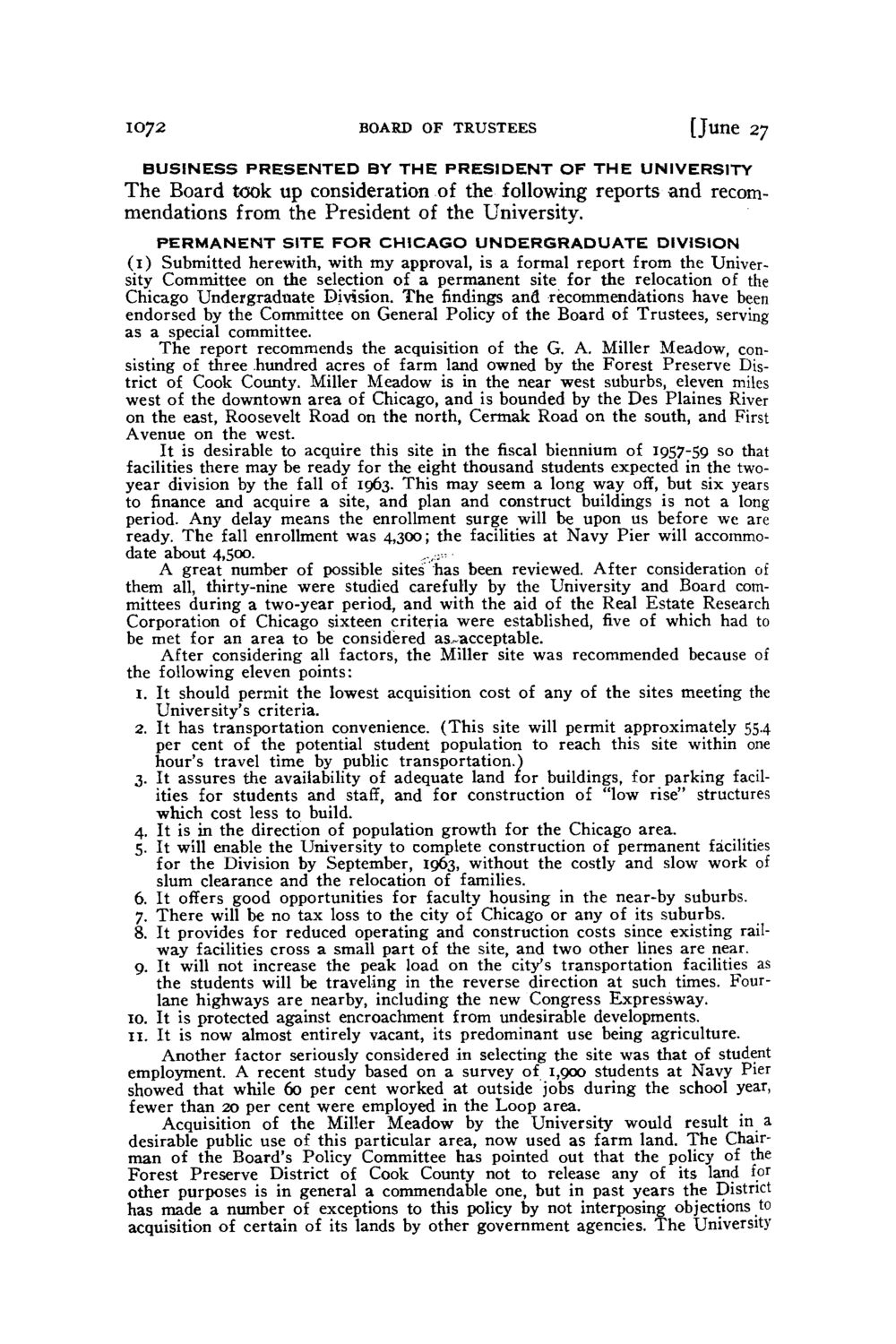| |
| |
Caption: Board of Trustees Minutes - 1956
This is a reduced-resolution page image for fast online browsing.

EXTRACTED TEXT FROM PAGE:
1072 BOARD OF TRUSTEES [June 27 B U S I N E S S P R E S E N T E D BY T H E P R E S I D E N T O F T H E UNIVERSITY The Board took up consideration of the following reports and recommendations from the President of the University. P E R M A N E N T SITE F O R CHICAGO U N D E R G R A D U A T E DIVISION (1) Submitted herewith, with my approval, is a formal report from the University Committee on the selection of a permanent site for the relocation of the Chicago Undergraduate Division. T h e findings and recommendations have been endorsed by the Committee on General Policy of the Board of Trustees, serving as a special committee. T h e report recommends the acquisition of the G. A. Miller Meadow, consisting of three hundred acres of farm land owned by the Forest Preserve District of Cook County. Miller Meadow is in the near west suburbs, eleven miles west of the downtown area of Chicago, and is bounded by the Des Plaines River on the east, Roosevelt Road on the north, Cermak Road on the south, and First Avenue on the west. It is desirable to acquire this site in the fiscal biennium of 1957-59 so that facilities there may be ready for the eight thousand students expected in the twoyear division by the fall of 1963. This may seem a long way off, but six years to finance and acquire a site, and plan and construct buildings is not a long period. Any delay means the enrollment surge will be upon us before we are ready. T h e fall enrollment was 4,300; the facilities at Navy Pier will accommodate about 4,500. ,.,;A great number of possible sites has been reviewed. After consideration of them all, thirty-nine were studied carefully by the University and Board committees during a two-year period, and with the aid of the Real Estate Research Corporation of Chicago sixteen criteria were established, five of which had to be met for an area to be considered as.-acceptable. After considering all factors, the Miller site was recommended because of the following eleven points: 1. It should permit the lowest acquisition cost of any of the sites meeting the University's criteria. 2. It has transportation convenience. (This site will permit approximately 55.4 per cent of the potential student population to reach this site within one hour's travel time by public transportation.) 3. It assures the availability of adequate land for buildings, for parking facilities for students and staff, and for construction of "low rise" structures which cost less to build. 4. It is in the direction of population growth for the Chicago area. 5. It will enable the University to complete construction of permanent facilities for the Division by September, 1963, without the costly and slow work of slum clearance and the relocation of families. 6. It offers good opportunities for faculty housing in the near-by suburbs. 7. There will be no tax loss to the city of Chicago or any of its suburbs. 8. It provides for reduced operating and construction costs since existing railway facilities cross a small part of the site, and two other lines are near. 9. It will not increase the peak load on the c i t / s transportation facilities as the students will be traveling in the reverse direction at such times. Fourlane highways are nearby, including the new Congress Expressway. 10. It is protected against encroachment from undesirable developments. 11. It is now almost entirely vacant, its predominant use being agriculture. Another factor seriously considered in selecting the site was that of student employment. A recent study based on a survey of 1,900 students at Navy Pier showed that while 60 per cent worked at outside jobs during the school year, fewer than 20 per cent were employed in the Loop area. Acquisition of the Miller Meadow by the University would result in a desirable public use of this particular area, now used as farm land. The Chairman of the Board's Policy Committee has pointed out that the policy of the Forest Preserve District of Cook County not to release any of its land for other purposes is in general a commendable one, but in past years the District has made a number of exceptions to this policy by not interposing objections to acquisition of certain of its lands by other government agencies. T h e University
| |